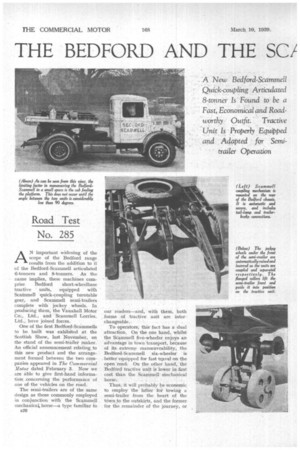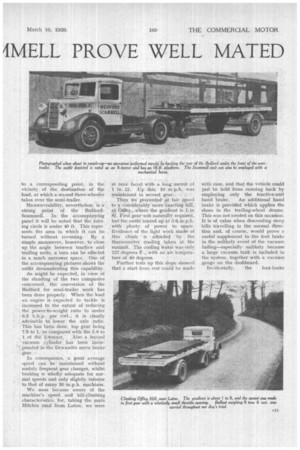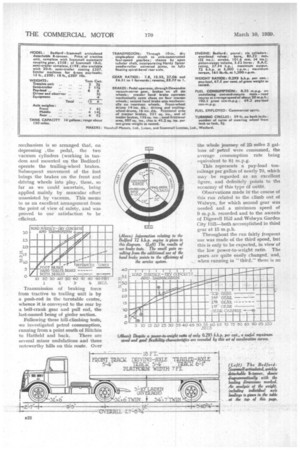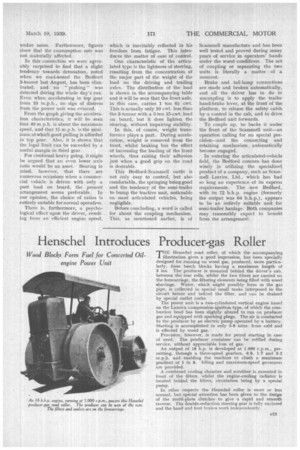THE BEDFORD AND THE SC/ 4MELL PROVE WELL MATED
Page 54

Page 55

Page 56

Page 57

If you've noticed an error in this article please click here to report it so we can fix it.
A New Bedford-Scammell Quick-coupling Articulated 8-tonner is Found to be a Fast, Economical and Roadworthy Outfit. Tractive Unit Is Properly Equipped and Adapted for Semitrailer Operation AN important widening of the scope of the Bedford range results from the addition to it of the Bedford-Scammell articulated 0-tonners and 8-tonners. As the name implies. these machines comprise Bedford short-wheelbase tractive units, equipped with Scammell quick-coupling turntable gear, and Scammell semi-trailers complete with jockey wheels. In producing them, the Vauxhall Motor Co., Ltd., and . Scammell Lorries, Ltd., ha.ve joined forces.
One of the first Bedfotd-Scammells to be built was exhibited at the Scottish Show, last November, on the stand of the semi-trailer maker. An official announcement relating, to this new product and the arrangement formed between the two companies appeared in The Commer riot Motor dated February 3. Now we are able to give first-hand information concerning the performance' of one of, the vehicles on the road.
The semi-trailers are of the same design as those commonly employed in conjunction with the Scammell mechanical, horse—a type familiar to B20 our readers—and, with them, both forms of tractive unit are inter. changeable.
To operators, this fact has a dual attraction. On the one hand, whilst the Scammell five-wheeler enjoys an advantage in town transPort, because of its extreme manoeuvrability, the Bedford-Scammell six-wheeler is better equipped for fast travel on the open road. On the other hand, the Bedford tractive unit is lower in first cost than the Scammell mechanical horse.
Thus, it will probably be economic to employ the latter for towing a semi-trailer from the heart of the tOwn .to the outskirts, and the former for the remainder of the journey, or
to a corresponding point, in the vicinity, of the destination of the load, at which a second three-wheeler takes over the semi-trailer.
Mameuvrability, nevertheless, is a strong point of the BedfordScammell. In the accompanying panel it will be noted that the turning circle is under 40 ft. This represents the area in which it can be turned without reversing. By a simple rnanceuvre, however, to close up the angle between tractive and trailing units, a turn can be effected in a much narrower space. One of the accompanying pictures shows the outfit demonstrating this capability.
As might be expected, in view of the standing of the two companies concerned, the conversion of the Bedford for semi-trailer work has been done properly. When the Toad an engine is expected to tackle is increased to the extent of reducing the power-to-weight ratio to under 0.3 .blip. per cwt., it is clearly advisable to lower the axle ratio. This has been done, top gear being 7.8 to 1, as compared with the 5.8 to
1 of the 3-tonner. Also a second vacuum c3linder has been incorporated in the Dewandre servo brake gear.
In consequence, a good average speed can be maintained without unduly frequent gear changes, whilst braking is wholly adequate for normal speeds and only slightly inferior to that of many 30 m.p.h. machines.
We soon became aware of the machine's speed and hill-climbing characteristics, for, taking the main Hitchin road from Luton, we were at once faced with a long ascent of 1 in .12. Up this 10 ru.p.h, was maintained in second gear. .
, Then We proceeded' at fair speed to a considerably more exacting hill, at Offley, Where the gradient is t in 8. First gear wa'S naturalIV required, but the. outfit toured up' at 5-0, m.p.h. with plenty: of power to spare. Evidence of the light work made of this climb • Is afforded by the thermometer reading taken at the summit. The cooling 'Water was only 157 degrees F., with an air temperature of 40 degrees.
Further tests up this slope showed that a start from rest could be made with ease, and that the vehicle could just be held from running back by employing only the tractive-unit hand brake. An additional hand brake is provided which applies the shoes in the trailing-wheel drums. This was not needed on this occasion. It is of value when descending steep hills travelling in the normal direction and, of course, would prove a useful supplement to the foot brake in the unlikely event of the vacuum failing—especially unlikely because a large vacuum tank is included in the system, together with a vacuum gauge on the dashboard.
Incidentally, the foot-brake mechanism is so arranged that, on depressing the pedal, the two vacuum cylinders (working in tandem and mounted on the Bedford) operate the trailing-wheel brakes. Subsequent movement of the foot brings the brakes on the front and driving wheels into play, these, so far as we could ascertain, being applied mainly by muscular effort unassisted by vacuum. This seems to us an. excellent arrangement from the point of view of safety, and was proved to our satisfaction to be efficient.
Transmission of braking force front tractive to trailing unit is by a push-rod in the turntable centre, whence it.is conveyed to the rear by a. bell-crank gear and pull rod, the last-named being of girder section.
Following these hill-climbing tests, we investigated petrol consumption, running from a point south of Hitchin to Hatfield and back. There are several minor undulations and three noteworthy hills on this route. Over _ the whole journey of 25 miles 3 gallons of' petrol were consumed, the average consumption rate being equivalent to Sli m.p.g.
This represents a pay-load tonmileage per gallon of nearly 70, which may • be regarded as an excellent figure, and definitely points to tht economy of this type 61 outfit.
'Observations made irfthe course of this run related to the climb out of Welwyn, for which second gear was needed and a minimum speed of 9 m.p.h. recorded and to the ascents of Digswell Hill and.Welwyn Garden City Hill—both accomplished in third gear at 15 m.p.h.
Throughout the run fairly frequent use was made of the third speed, but this is only to be expected, in view of the low power-to-weight ratio. The gears are quite easily changed, and, when running in" third." there is no undue noise. Furthermore, figures show that the consumption rate was not materially affected.
In this connection we were agreeably surprised to find that a slight' tendency towards detonation, noted when we road-tested the Bedford 3-tonner last August, has been eliminated, and no " pinking " was detected during the whole day's run. Even when accelerating in top gear from 10 m.p.h., no sign of distress from the power unit was evinced.
From the graph giving the acceleration characteristics, it will be seen that 40 m.p.h. is about the maximum speed, -and that 15 m.p.h. is the minimum at which good pulling is afforded in top gear. Also, it is shown that the legal limit can be exceeded by a useful margin -in third gear.
For continual heavy going, it might be argued that an even lower axle ratio would be an asset. Bearing in mind, however, that there are numerous occasions when a commercial vehicle is driven with only 'a part load on board, the present arrangement seems preferable. In our opinion, the choice of ratios is entirely suitable for normal operation.
There is, furthermore, a psychological effect upon the 'driver, resulting from an efficient engine speed, which is inevitably reflected in his freedom from fatigue. This introduces the matter of ease of control.
One characteristic of the articulated type is the lightness of steering, resulting from the concentration of the major part of the weight of the load on the driving and trailing axles. The distribution of the load is shown in the accompanying table and it will be seen that the front axle, in this case, carries 1 ton 6/cwt. This is actually only 10 cwt, less than the 3-tonner with a 3-ton 15-cwt. load on board, but it does lighten the steering, without impairing stability.
In this, of course, weight transference plays a part. During acceleration, weight is removed from the front, whilst braking has the effect of increasing the loading of the front wheels, thus raising their adhesion just when a good grip on the road is desirable.
This Bedford-Scammell outfit is not only easy to control, but also comfortable, the springing being good and the tendency of the semi-trailer to bump the tractive unit, noticeable on most articulated vehicles, being
negligible. Before concluding, a word is called for about the coupling mechanism. This, as mentioned earlier, is of Scammell manufacture and has been well tested and proved during many years of service in operators' hands under the worst conditions. The act of coupling or separating the two units is literally a matter of a moment.
Brake and tail-lamp connections are made and broken automatically, and all the driver has to do in uncoupling is to apply the trailer hand-brake lever, at the front of the platform, to release the safety catch by a control in the cab, and to drive the Bedford unit forwards.
To couple up, he backs it under the front of the Scamrnell unit—an operation calling for no special precision—and the connecting and retaining mechanism, automatically become engaged.
In entering the articulated-vehicle field, the Bedford concern has done wisely in utilizing the specialized product of a company, such as Scammell Lorries, Ltd., which has had so long an experience of its express requirements. The new Bedford, with its 72 b.h.p. engine (formerly the output was 64 b.h.p.), appears to be an entirely suitable unit for semi-trailer haulage. Both companies may reasonably expect to benefit from the arrangement:




























































































